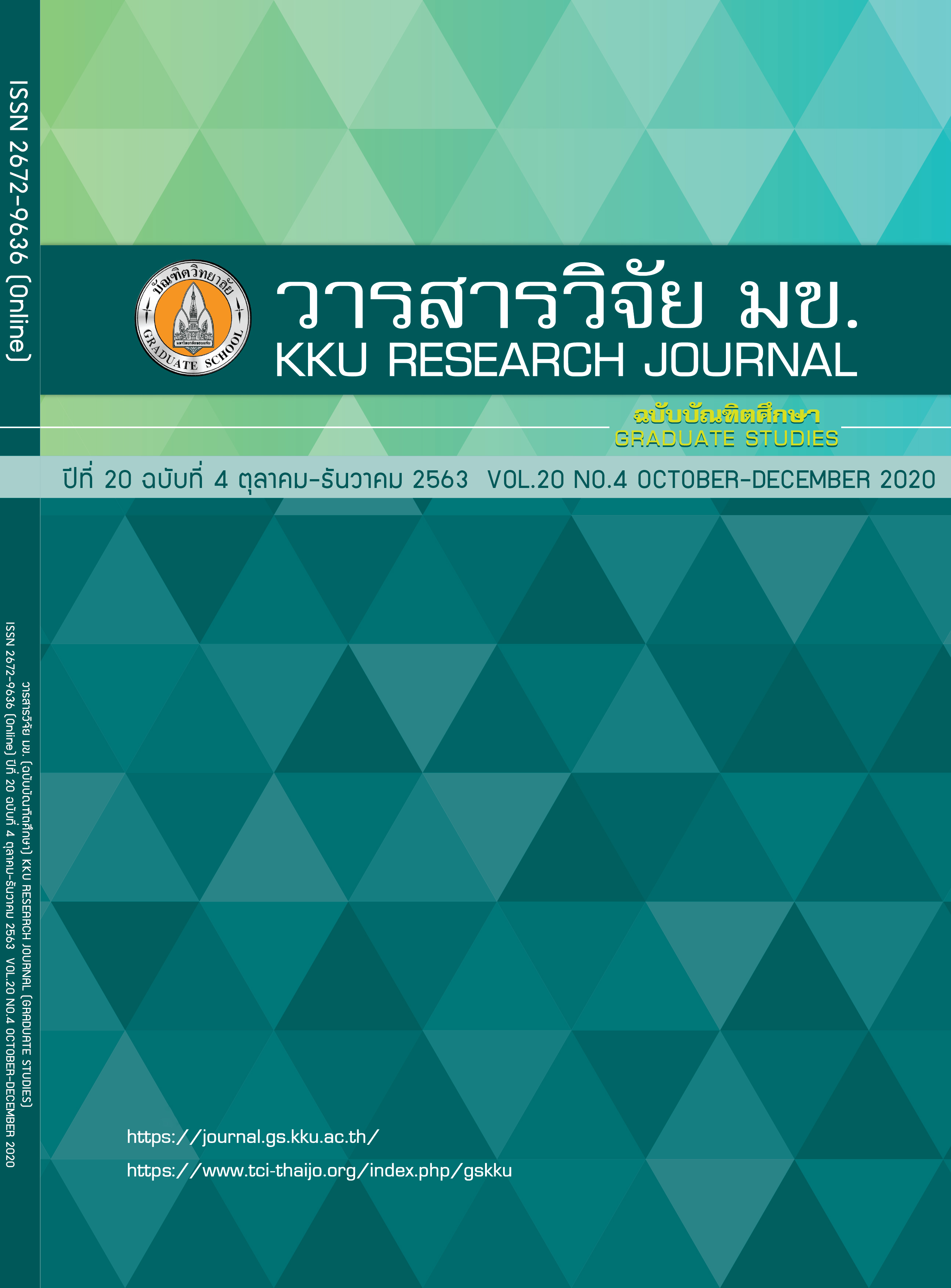Adsorption of Phenol in Aqueous Solution by Durian Shell Charcoal with Chemical Activation
Keywords:
Durian shell charcoal, Phenol, AdsorptionAbstract
The phenol adsorption potential of various types of durian shell charcoal were investigated. Batch experiment was carried out to determined the effect of 12 types of charcoal (deactivated granule, pellet and powder charcoal, granule, pellet and powder activated with ZnCl2, H3PO4 and KOH), initial concentration of phenol, contact time, pH and isotherm. The KOH-activated powder charcoal gave the better adsorption efficiency (100 %) than 11 types of charcoal at the optimum condition (10 mg/L, pH 5 and contact time 120 min). The adsorption model was fitted to Freundlich isotherm. Furthermore, the KOH-activated powder charcoal was applied to remove phenol in aqueous solution with industrial effluent concentration range (30, 100,300 and 800 mg/L). The results revealed that all of concentration, phenol was removed at 84.91, 85.48, 87.05 and 89.79 respectively. Therefore, the KOH-activated powder charcoal has enough potential to remove phenol in solution.
References
Suchada C. Antiseptic Phenolic [Internet]. 2008. [updated 2008 December 9; cited 2019 October 31]. Available from: http://www.chemtrack.org.
Ministry of Science Technology and Environment. Specific type of factory and industrial estate as the hazardous waste source which need to be control the waste water before released; 1996 Aug. 5 p.
Kaouah F, Boumaza S, Berrama T, Trari M, Bendjama Z. Preparation and characterization of activated carbon from wild olive cores (oleaster) by H3PO4 for the removal of Basic Red 46. Journal of Cleaner Production. 2013; 54: 296-306.
Tan IA, Ahmad AL, Hameed BH. Preparation of activated carbon from coconut husk: Optimization study on removal of 2, 4, 6-trichlorophenol using response surface methodology. Journal of Hazardous Materials. 2008; 153: 709-717.
Saka C. BET, TG–DTG, FT–IR, SEM, iodine number analysis and preparation of activated carbon from acorn shell by chemical activation with ZnCl2. Journal of Analytical and Applied Pyrolysis. 2012; 95: 21–24.
Yagmur E, Tunc M, Banford A, Zeki A. Preparation of activated carbon from autohydrolysed mixed sou-thern hardwood. Journal of Analytical and Applied Pyrolysis. 2013; 104: 470-478.
Chu W. Dye Removal from Texile dye Wastewater using Recycle Alum Sludge. Water Research. 2001; 32(13): 3147-3152.
Budsaba S, Padcharee P, Wittaya R. Adsorption of Phenol from aqueous solution by zeolite NaY synthesized from rice husk, Program in Chemistry, Faculty of Education, Nakhon Ratchasima Rajabhat University, Thailand. 2015.
Juwannee S. Feasibility study of corneob to remove phenolic compounds in wastewater [MS thesis]. Songkla: Prince of Songkla University; 2004. Thai.
Kusumal L. Removal of Phenolic Compounds by Palm Oil Mill Wastewater Treatment Plant and Land Treatment [MS thesis]. Songkla: Prince of Songkla University; 2014. Thai.
Theeradit P. Activated Carbon from Agricultural Residues by Chemical Activation for the Application of Pollutant Removal in Water. J. Res. Unit Sci. Technol. Environ. Learning. 2017; 8(1): 196-214. Thai.
Amin N.K. Removal of reactive dye from aqueous solution by adsorption onto activated carbon prepared from sugarcane bagasse pith. Desalination. 2008; (223): 152-161.
Kaouah F, Boumaza S, Berrama T, Trari M, Bendjama Z. Preparation and characterization of activated carbon from wild olive cores (oleaster) by H3PO4 for the removal of Basic Red 46. Journal of Cleaner Production. 2013; 54: 296-306.
Prasong A. Treatment of Wastewater Contaminated with Cr (VI) by Adding Powdered Activated Carbon in the Activated sludge Process [MS thesis]. Bangkok: Kasetsart University; 2002. Thai.



